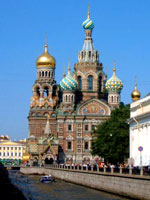 St. Petersburg OverviewSituated on the Gulf of Finland and spread over numerous islands
in the Neva Delta, St Petersburg is a city of arched bridges,
winding canals, wide boulevards, elegant palaces, impressive
squares and ornate churches, and as such is often referred to as
the 'Venice of the North'. It has an elegance also reminiscent of
cities like Paris, Berlin and Amsterdam, but is at the same time
too Russian to be European, and beguiles with a charm of its
own. It is the country's most beloved and beautiful city, founded by
Peter the Great in 1703. It became the original capital of Tsarist
Russia, and the greatest artists, sculptors and architects worked
together to create the city's unique look. Rich aristocratic
palaces and government buildings line the streets, along with
majestic cathedrals and elaborate churches, from the golden spires
of St Peter and Paul Cathedral, the magnificent gleaming dome and
grand colonnaded façade of St Isaac's, to the colourful multi-domed
Church of the Resurrection. Although the Russian capital moved to Moscow after the
Revolution, the city remains the principal artistic and cultural
centre of the country. St Petersburg is the birthplace of Russian
ballet and performances by the Kirov Ballet, rivalling the Bolshoi
ballet in Moscow, are shown in the historic Mariinsky Theatre. The
magnificent green and white Winter Palace forms part of the
Hermitage Museum, one of the world's greatest art galleries, and
the city's foremost attraction. With its romantic waterways and decorative tsarist architecture,
St Petersburg is also the perfect setting for the famous 'White
Nights', and the summer months of June and July are crowded with
visitors who come to experience the dreamy twilight that takes the
place of night, an occurrence due to its northerly latitude when
the sun never dips far enough below the horizon to create total
darkness, along with music festivals and cultural events. |